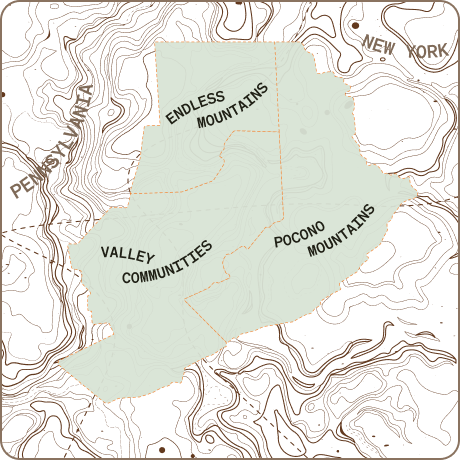As the summer heat continues, many Northeastern Pennsylvanians are cooling down with NEPA’s waters. Last time, North Branch Land Trust discussed the water recreation possibilities in our region and how they are all connected to one another. This time, they’re taking a deeper dive into how healthy waterways benefit us all and what we can do to help maintain the balance.
Small Changes Can Make a Big Impact on Our Local Waters
Water is connection. Once you pour one glass of water into another, they are forever mingled. Any waterway will find another—a raindrop that falls on the highest tree on the tallest mountain in Pennsylvania can make it all the way to the Atlantic Ocean. But if you just focus on the water, you are not seeing the big picture!
A healthy watershed is connected to a healthy ecosystem, and it is all about balance. This means that what happens to NEPA’s waters can affect every single one of us. Obviously, these waters are where we (and other living things) drink and play. It allows for lush vegetation and varied invertebrates. It provides a home for fish and amphibians. No matter how you eat, work, or play, NEPA’s waters are going to be involved. However you look at it, almost everything we enjoy here in NEPA owes some debt of gratitude to our healthy waterways.

A healthy watershed works behind the scenes to help our lands withstand extreme weather, making areas less susceptible to flash flooding or short-term drought. This stability also allows for more varied plant life, which in turn supports more grazing animals, which in turn allows for a healthy predator population. Indeed, organisms living in a healthy ecosystem are better able to resist disease and illness. But like any delicate system, small changes can drastically tip the balance.
The biggest threats to NEPA’s healthy waters are pollution, rising temperatures and invasive species. And believe it or not, those are all connected too! When we talk about “pollution,” we really mean any contaminant that causes adverse change. So, while litter might be the first thing to come to mind, the greatest damage comes from sewage and wastewater, fertilizers, antibiotics and microplastics that can enter the ground or surface water. When they enter the water cycle, detergents and other chemicals can harm beneficial native species, whereas excess fertilizers can lead to algal blooms. Combined with suspended sediment and microplastics, imbalanced water systems tend to absorb more sunlight, heating the waterbody above normal temperatures. Warm water can hold less dissolved oxygen, whereas many aquatic species like Pennsylvania’s state fish, the brook trout, require cool, oxygen-rich streams to thrive. Without healthy competition from native species, invasive species like didymo, curly-leaf pondweed and zebra mussels can rapidly disrupt an ecosystem.

Many of NEPA’s waters are constantly balancing and rebalancing in response to changes in the environment, but we can all pitch in to help. Many solutions require community-wide or governmental support, like maintaining native vegetative buffers or storm drain catch basins. Many more solutions are easy (and important) for all of us to incorporate, even if you only occasionally make a splash in NEPA’s waters.
The best way for an individual to keep contaminants out of the watershed is to sequester, or securely stash away, domestic waste. What that means specifically is up to you! If you are an artist, sequestering your waste would mean allowing unusable paint to harden before throwing it away. If you are a car enthusiast, it could mean taking used motor oil to a recycling center or auto parts store to be refined and reused. Even small changes like swapping a front yard car wash for a drive-through option can mean that wastewater is treated and recycled rather than entering the watershed where it can raise water temperatures and help invasive species flourish.

If you enjoy boating, swimming, hiking or kayaking around NEPA’s waters, you can also be an important defender against the spread of those aquatic invasives. While some invade an area by natural waterways, much of their spread occurs through “hitchhiking.” These species often become attached to a hull, a shoe or a motor when it leaves one body of water and attaches itself to another. Taking time to wipe down equipment before moving to a new location is best way to keep an eye out for hitchhikers.
Want to be an even bigger watershed defender? Learn to identify the most problematic aquatic invasives in your area and report them to PA iMap Invasives.

NEPA’s natural resources are our region’s greatest treasures, and they can thrive thanks to our wonderful waters. Whether you are fishing, swimming, splashing around or just enjoying a cool glass of water in the AC, we hope you take time to consider some small changes to make a big impact on the health of our local waters!
Learn more about North Branch Land Trust and their mission at nblt.org.
Learn more about aquatic invasives with Sea Grant Pennsylvania and PA iMap Invasives.
Learn more about Pennsylvania wastewater management programs by visiting the Penn State Extension and the Pennsylvania Department of Environmental Protection.































